The Economics and Statistics Division maintains archives of previous publications for accountability purposes, but makes no updates to keep these documents current with the latest data revisions from Statistics Canada. As a result, information in older documents may not be accurate. Please exercise caution when referring to older documents. For the latest information and historical data, please contact the individual listed to the right.
<--- Return to Archive
For additional information relating to this article, please contact:
May 16, 2023ANALYSIS OF CONSUMER PRICE INDEX FOR APRIL 2023 Nova Scotia’s all items Consumer Price Index (CPI) increased 4.5% year-over-year in April 2023. This was the lowest year-over-year inflation rate reported for Nova Scotia since June of 2021. Nova Scotia's inflation has been slowing after peaking at 9.3% in June 2022. Nationally, consumer prices increased 4.4% year-over-year in April 2023, accelerating slightly from a 4.3% increase in March. Inflation was highest in Manitoba and lowest in Newfoundland and Labrador.
The most significant upward contributors (combining price increase as well as share of the consumption basket) to Nova Scotia's 4.5% year-over-year inflation were: rent, mortgage interest cost, purchase/leasing of passenger vehicles, food purchased from restaurants and personal care supplies/equipment. These were offset by sizable downward year-over-year contributions from: gasoline, fuel oil, childcare/housekeeping services, furniture and internet services.
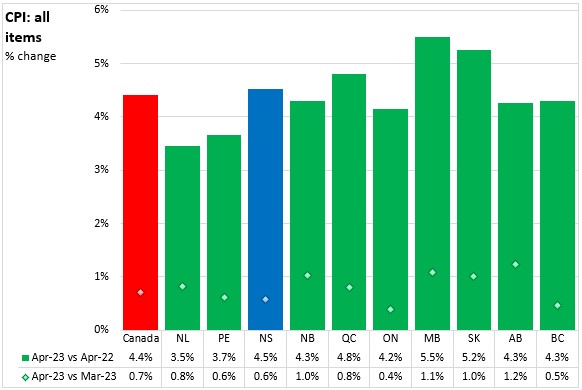
On a monthly basis, Nova Scotia's all items CPI was up 0.6% March to April 2023. National prices were up 0.7% with increases in every province. Alberta reported the fastest monthly inflation while Ontario and British Columbia reported the slowest monthly price growth.
Nova Scotia's monthly inflation was influenced by upward contributions from: gasoline, electricity, rent, purchase/operation of recreational vehicles and health care services. These upward contributors to Nova Scotia's monthly CPI were offset by some notable downward contributors: fuel oil, homeowners' maintenance/repairs, furniture, travel tours and childcare/housekeeping services
Energy prices play a significant role in inflation rates. Nova Scotia's energy prices were down 4.6% from April 2022 to April 2023. Year-over-year energy prices were down 4.2% nationally with declines in all provinces except Saskatchewan. Newfoundland and Labrador reported the largest drop in year-over-year energy prices.
On a monthly basis, Nova Scotia's energy prices increased 3.6% from March to April 2023. National energy prices were up 3.4% from March to April with gains in all provinces except Prince Edward Island. Alberta reported the largest monthly increase in energy prices.
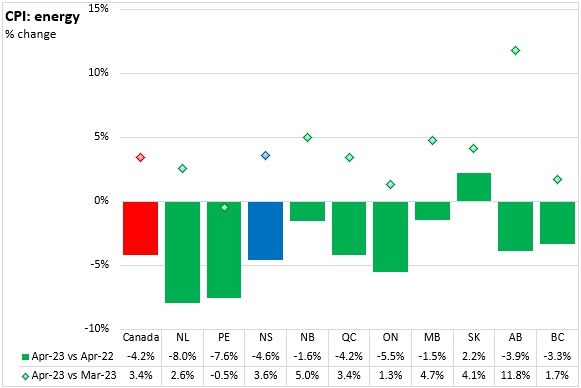
Because fuel oil for home heating is a larger component of Nova Scotia's consumption basket than in other provinces, Nova Scotia's energy prices (and overall inflation) are more sensitive to fluctuations in the global price of crude oil. Nova Scotia's energy prices accelerated dramatically after Russia's invasion of Ukraine in March 2022. Nova Scotia energy prices peaked in May 2022 and have since been trending down, though there was a substantial increase in October and November.
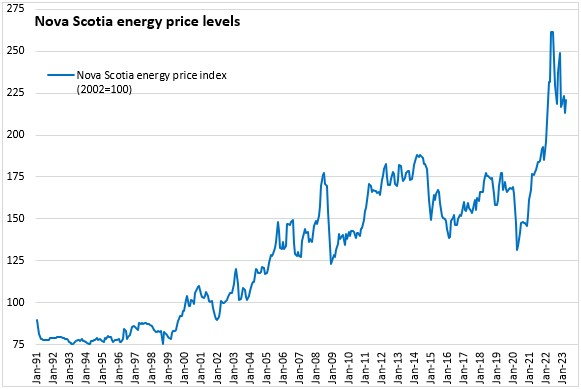
Nova Scotia's year-over-year decline in energy prices (-4.6%) was the second consecutive decline.
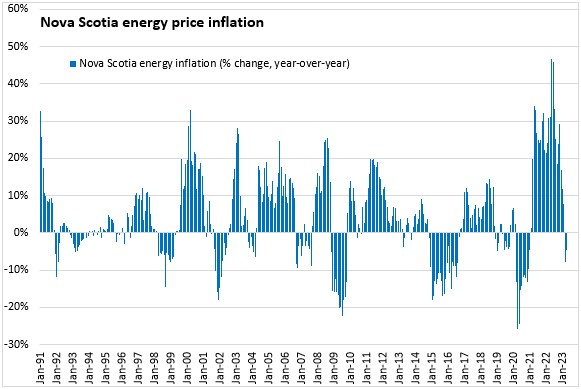
Food price inflation was 8.5% in Nova Scotia (April 2023 vs April 2022), down from the 9.6% year-over-year pace of inflation reported in March 2023. National food prices decelerated to 8.3% growth. Food prices were up in all provinces; Manitoba reported the highest food price inflation while British Columbia reported the least food price growth (though it was still 7.5%).
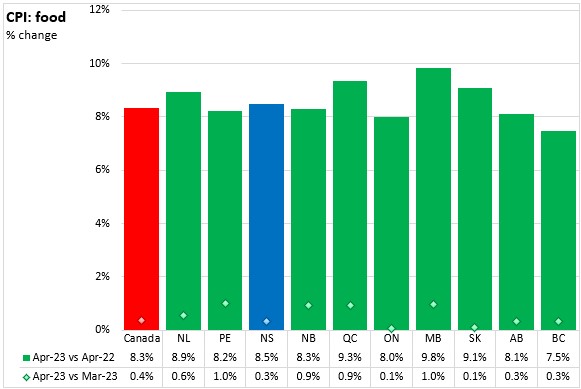
On a monthly basis, Nova Scotia's food prices were up 0.3% from March to April. National growth in food prices was 0.4% from March to April with gains in all provinces (leading: Manitoba and Prince Edward Island, lagging: Ontario and Saskatchewan).
Food and energy prices are heavily influenced by volatile global commodity markets. Nova Scotia's underlying inflation rate excluding food and energy was 5.0% from April 2022 to April 2023. This was the second fastest among provinces (after Manitoba). Nationally, inflation excluding food and energy was 4.4%. Newfoundland and Labrador reported the slowest growth in inflation excluding food and energy prices.
On a monthly basis, Nova Scotia's inflation for all items excluding food and energy was 0.2% from March to April 2023, slowest among provinces. Prices for all items excluding food and energy were up 0.5% nationally with gains in all provinces. The fastest monthly growth was in Saskatchewan.
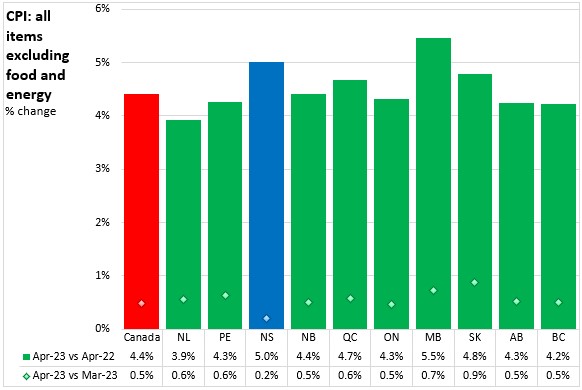
Shelter cost inflation slowed to 4.8% in Nova Scotia from April 2022 to April 2023, decelerating considerably from 5.5% year-over-year increases reported in March and 9.7% year-over-year increases reported in February. National shelter prices were up 4.9% with year-over-year gains in all provinces led by Saskatchewan. Prince Edward Island reported the slowest year-over-year increase in shelter prices.

Monthly shelter costs were up 0.2% in Nova Scotia from March to April 2023. Nationally, shelter costs were up 0.6% from March to April with gains in all provinces except Prince Edward Island. Alberta reported the fastest gains in monthly shelter costs.
Among detailed food products with available data, Nova Scotia's year-over-year inflation was fastest for preserved fruits while many food products reported year-over-year inflation in excess of 10% in April. All food products reported year-over-year price growth in April.

In detailed shelter cost components, rent reported the fastest year-over-year price increases while fuel oil prices were down.
Household operations/furnishings costs were up 1.4% overall. Prices were down for childcare/housekeeping, internet access, financial services, furniture and utensils/tableware/cookware. Year-over-prices were up most for paper/plastic/aluminium foil products.
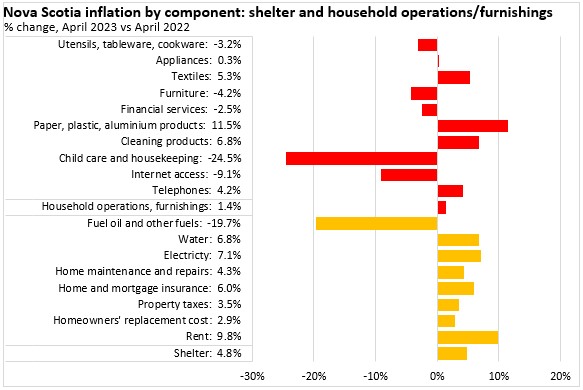
Overall transportations costs were up 1.7% year-over-year in April owing to the substantial gains in taxi/local transportation, purchasing/leasing of passenger vehicles and parts/maintenance/repairs from April 2022 to April 2023.
Health and personal care costs were up 7.6% year-over-year on gains in personal care supplies, non-prescribed medicines and health care services.
Clothing and footwear prices were up 6.1% year-over-year with faster gains in men's clothing and clothing accessories/jewellery prices.
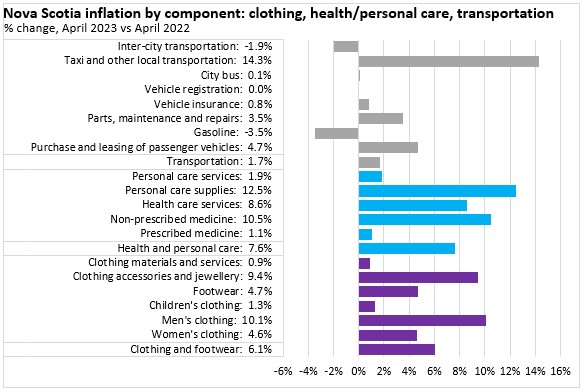
Nova Scotia's overall prices for recreation, education and reading were up 4.5% from April 2022 to April 2023 with faster increases for travel services/accommodations, offset by falling prices for home entertainment equipment/services.
Nova Scotia's prices for alcohol, tobacco and recreational cannabis were up 5.3% year-over-year with the fastest growth in price for liquor purchased from stores as well as alcohol purchased from licensed establishments.
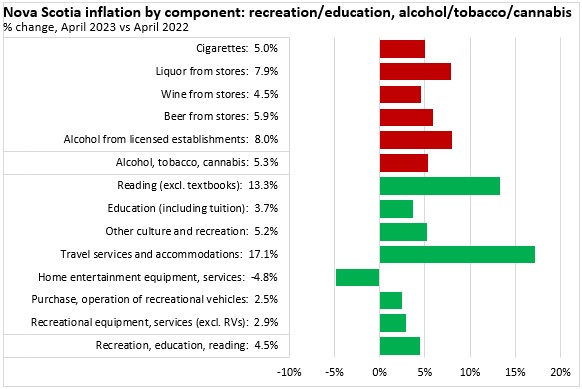
Trends
Since the start of the Bank of Canada's inflation-targeting monetary policy regime, inflation for all items has periodically risen above a 4% year-over-year pace. This is typically followed by periods of slow price growth or even negative price changes. The most recent acceleration in inflation was the strongest since the inflation-targeting era began.
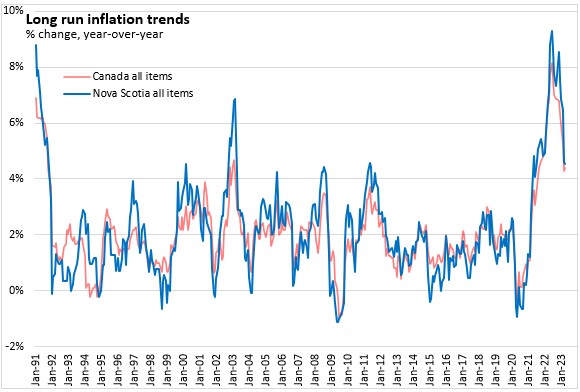
Many of these periods of accelerated and slowed inflation are attributable to volatile commodity prices, especially energy prices. Once the more volatile commodity prices are excluded, inflation in Nova Scotia has largely been below 2% for much of the last 20 years. However, the recent rise in inflation in 2021 and 2022 spread beyond commodity prices and has only recently started to edge down at the national level.
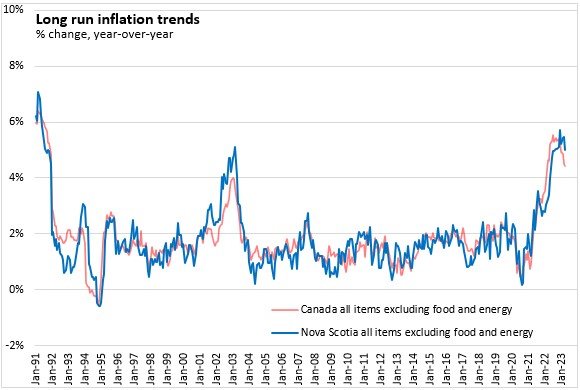
The Bank of Canada examines 'core' measures of inflation that are intended to remove the effects of volatile components and capture underlying inflation trends that are more connected to capacity in the Canadian economy. Core measures of inflation may also indicate where all items inflation is headed.
Canada's core measures of inflation remained mostly at or below the Bank's target of 2% for over a decade prior to 2021. However, after prices accelerated in 2022, core inflation measures also started to rise, peaking at over 6% for the CPI-common measure before declining in recent months.
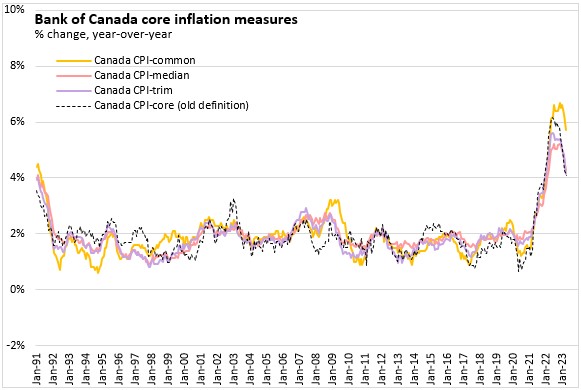

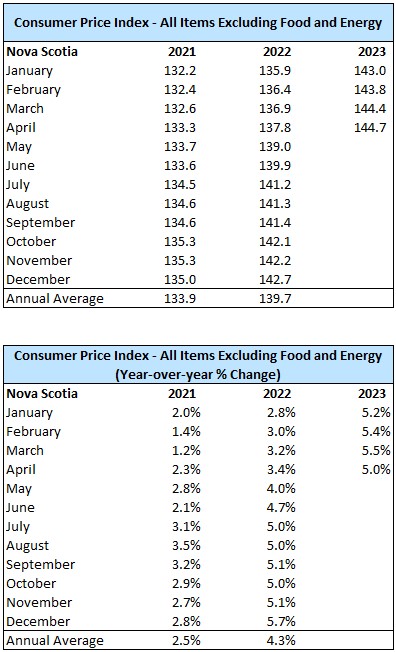
Source: Statistics Canada. Table 18-10-0004-01 Consumer Price Index, monthly, not seasonally adjusted; Table 18-10-0256-01 Consumer Price Index (CPI) statistics, measures of core inflation and other related statistics - Bank of Canada definitions
<--- Return to Archive